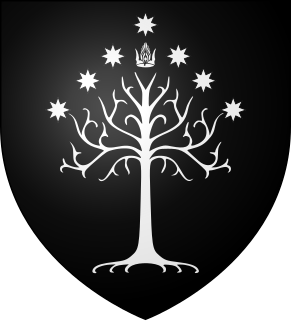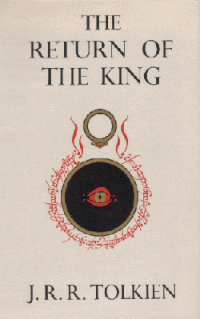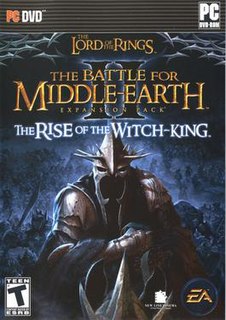Regarding the Fall of Arthedain
At the birth of the son of Araphant Malbeth said
- "Arvedui you shall call him, for he will be the last in Arthedain. Though a choice will come to the Dúnedain, and if they take the one that seems less hopeful, then your son will change his name and become king of a great realm. If not, then much sorrow and many lives of men shall pass, until the Dúnedain arise and are united again."
This prophecy was to be fulfilled in the year T.A. 1975. After a terrible defeat when the armies of Angmar, led by the Witch-king of Angmar, assailed Fornost, Arvedui fled Arnor, going far into the snowy North in order to evade death at the hands of the Witch-king's army. When a ship was sent by Círdan of the Grey Havens to rescue him, he was cautioned by the Lossoth to await the thaw to set off. Not heeding their words, Arvedui set sail straight away and was shipwrecked and died in the ice-bay of Forochel. Thus the prophecy came to pass; the rule of his people passed on to lesser men who could not truly control the realm. The chieftains of the Dúnedain ruled for many generations, until they were united by Aragorn, son of Arathorn, when he ascended to the throne of Gondor and Arnor, in time returning the kingdom of Arnor to its former glory.

Angmar is a fictional kingdom in J. R. R. Tolkien's continent of Middle-earth, at the north end of the Misty Mountains. It was used by the Lord of the Ringwraiths as a base from which to attack the kingdoms of the Dúnedain in the North, all of which were eventually destroyed. Angmar itself was subsequently destroyed by combined armies of men and elves shortly thereafter.
The Witch-king of Angmar, also known as the Lord of the Nazgûl and the Black Captain, is a character in Tolkien's legendarium. In J. R. R. Tolkien's The Lord of the Rings, he is the chief of the Nazgûl or "Ringwraiths", the chief servants of the Dark Lord, Sauron. His name is not revealed in any of Tolkien's writings, nor are the names of any of the other Nazgûl except Khamûl.

Arnor is a fictional kingdom in J. R. R. Tolkien's writings. Arnor, or the North-kingdom, was a realm of the Dúnedain in the region of Eriador in Middle Earth. Arnor was founded near the end of the Second Age (S.A. 3320) by Elendil, whose sons Isildur and Anárion founded Gondor at the same time. The history of the two kingdoms is intertwined; both kingdoms are known as the Realms of the Dúnedain in Exile.
Alternatively, this prophecy may refer to the choices made by the Dúnedain of Gondor, where Arvedui claimed the crown in T.A. 1944, by virtue of his descent from Isildur and his marriage to Fíriel, the only surviving child of the late King, Ondoher. The Council of Gondor, led by the Steward Pelendur, rejected Arvedui's claim, choosing instead their victorious general Eärnil, a male-line descendant of Anárion. The Appendices to the Lord of the Rings speculate that if the Crown of Gondor had instead been given to Arvedui, "it may be that...the kingship would have been maintained and much evil averted." Instead, the realm of Arthedain was destroyed, and the kingship of Gondor fell vacant shortly afterwards.
Isildur is a fictional character in J. R. R. Tolkien's legendarium. He appears in the author's books The Lord of the Rings, The Silmarillion, and Unfinished Tales.
Pelendur is a fictional character in J. R. R. Tolkien's Lord of the Rings, appearing The Return of the King.
Anárion is a fictional character in J. R. R. Tolkien's Middle-earth legendarium. His name is derived from Anar, which means "Sun" in Tolkien's invented language of Quenya. He was the son of Elendil and the brother of Isildur, and with them established the Realms in Exile in Middle-earth after the downfall of Númenor.
Regarding the summoning of the Dead
Regarding the summoning of the Dead by the heir of Isildur, Malbeth made a second prophecy that again was fulfilled in time. In the year 3019 of the Third Age, Elrond of Rivendell sent word to Aragorn, son of Arathorn, to remember the words of the seer at his time of need. After learning of the impending assault of the Corsairs of Umbar on Minas Tirith by using the palantír of Orthanc, Aragorn discovered that only by walking the Paths of the Dead could he reach Minas Tirith in time to offer aid. Acknowledging this, he chooses that route and accompanied by the Grey Company he passed through and out to the Stone of Erech. In The Lord of the Rings: The Return of the King's extended edition, Legolas can be heard quoting part of the prophecy. As the heir of Isildur, Aragorn summoned the Dead Men of Dunharrow to him and with their aid defeated the Corsair threat to Gondor, fulfilling the prophecy of Malbeth.
Elrond Half-elven is a fictional character in J. R. R. Tolkien's Middle-earth legendarium. He is introduced in The Hobbit, and plays a supporting role in The Lord of the Rings and The Silmarillion.

Rivendell is a valley in the fictional world of Middle-earth created by J. R. R. Tolkien. It was established in the Second Age by Elrond Half-elven, who protected it with the powers of his elven ring Vilya and ruled it until the events of The Lord of the Rings four or five thousand years later. It is an important location in Tolkien's legendarium, featured in The Hobbit, The Lord of the Rings, The Silmarillion, and Unfinished Tales.
The Corsairs of Umbar were a fleet of Men of Umbar in J. R. R. Tolkien's Middle-earth legendarium, allied to Sauron in his war against Gondor.

Gondor is a fictional kingdom in J. R. R. Tolkien's writings, described as the greatest realm of Men in the west of Middle-earth by the end of the Third Age. The third volume of The Lord of the Rings, The Return of the King, is largely concerned with the events in Gondor during the War of the Ring and with the restoration of the realm afterward. The history of the kingdom is outlined in the appendices of the book.
In J. R. R. Tolkien's Middle-earth fiction, such as The Hobbit and The Lord of the Rings, the terms Man and Men refer to humankind – in contrast to Elves, Dwarves, Orcs, and other humanoid races – and does not denote gender. Hobbits were a branch of the lineage of Men.
A palantír is a fictional magical artefact from J. R. R. Tolkien's Middle-earth legendarium. A palantír is described as a crystal ball, used for both communication and as a means of seeing events in other parts of the world or in the distant past or in the future.

The Return of the King is the third and final volume of J. R. R. Tolkien's The Lord of the Rings, following The Fellowship of the Ring and The Two Towers. The story begins in the kingdom of Gondor, which is soon to be attacked by the Dark Lord Sauron.
Elendil is a fictional character in J. R. R. Tolkien's legendarium. He appears in The Lord of the Rings, The Silmarillion and Unfinished Tales.

Minas Morgul also known by its earlier name of Minas Ithil is a fictional fortified city in J. R. R. Tolkien's Middle-earth.

According to J. R. R. Tolkien's legendarium of Middle-earth, the Stewards of Gondor – also styled the Lords of Minas Tirith – were lords of the fictional kingdom of Gondor, who resided in Minas Tirith, the capital city. The Steward was appointed by the King, and could act on behalf of the King when the King was absent from the city or incapacitated.
Arvedui is a fictional character from J. R. R. Tolkien's Middle-earth legendarium, who was the last King of Arnor before its destruction.
In J. R. R. Tolkien's legendarium, the Rangers of the North, also known as the Dúnedain of the North, were the descendants of the Dúnedain from the lost kingdom of Arnor. They were Men, and one of the Free Peoples of Middle-earth. Their menfolk ceaselessly patrolled the boundaries of Eriador and were by necessity skilled with the sword, bow, and spear.
In J.R.R. Tolkien's Middle-earth, the High Kings of Arnor and Gondor were the Kings of all Dúnedain in Middle-earth after the Downfall of Númenor. Elendil was the leader of the Elendili who survived the Downfall. He claimed the title of High King.

The Lord of the Rings: The Battle for Middle-earth II: The Rise of the Witch-king is a real-time strategy video game published by Electronic Arts, based on the Lord of the Rings film series based on the book, directed by Peter Jackson. The Rise of the Witch-king is the official expansion to The Lord of the Rings: The Battle for Middle-earth II, which was published by the same company and released in 2006, for Microsoft Windows. The Rise of the Witch-king was shipped to stores in the United States on November 28, 2006 and was officially released on November 30, 2006.
J. R. R. Tolkien's Middle-earth fantasy writings include many wars and battles set in the lands of Aman, Beleriand, Númenor, and Middle-earth. These are related in his various books such as The Hobbit and The Lord of the Rings, and The Silmarillion, Unfinished Tales and other posthumously published books edited by his son Christopher Tolkien.
In J. R. R. Tolkien's legendarium, the Dúnedain were a race of Men descended from the Númenóreans who survived the sinking of their island kingdom and came to Eriador in Middle-earth, led by Elendil and his sons, Isildur and Anárion. They are also called the Men of the West and the Men of Westernesse. They settled mainly in Arnor and Gondor.
Aragorn II, son of Arathorn is a fictional character from J. R. R. Tolkien's legendarium. He is one of the main protagonists of The Lord of the Rings. Aragorn was a Ranger of the North, first introduced with the name Strider at Bree, as the Hobbits continued to call him throughout The Lord of the Rings. He was eventually revealed to be the heir of Isildur and rightful claimant to the thrones of Arnor and Gondor. He was also a confidant of Gandalf and an integral part of the quest to destroy the One Ring and defeat the Dark Lord Sauron.
This page is based on this
Wikipedia article Text is available under the
CC BY-SA 4.0 license; additional terms may apply.
Images, videos and audio are available under their respective licenses.











